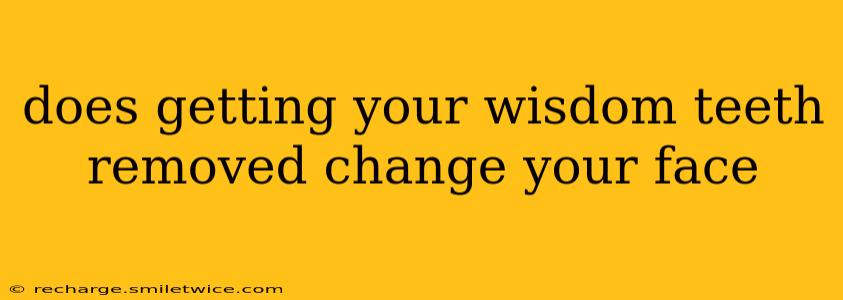Does Getting Your Wisdom Teeth Removed Change Your Face?
The question of whether wisdom teeth removal alters facial appearance is a common one, sparking curiosity and sometimes anxiety among those facing this procedure. While the impact is generally subtle and often unnoticeable, understanding the potential changes can help manage expectations. This article delves into the complexities of this topic, addressing common concerns and providing informative answers.
What Happens During Wisdom Teeth Removal?
Before addressing facial changes, let's understand the procedure. Wisdom teeth, the third molars, often lack sufficient space to erupt properly. Impacted wisdom teeth (those unable to fully emerge) can cause pain, infection, or damage to adjacent teeth. Removal involves surgically extracting these teeth, sometimes requiring incisions and stitches. The healing process involves bone and gum tissue regeneration.
Will Removing My Wisdom Teeth Change the Shape of My Face?
This is perhaps the most frequently asked question. The short answer is: it's possible, but usually minimal and temporary. The swelling and bruising associated with the procedure can temporarily alter facial contours. However, once the healing process is complete (typically several weeks), the swelling subsides, and any temporary changes usually disappear. Significant, lasting alterations to facial structure are rare.
Can Wisdom Teeth Removal Affect My Jawline?
The jawbone supports the teeth. Extracting wisdom teeth sometimes involves some minor bone removal, especially if the teeth are impacted. This bone removal can be minimal and unlikely to cause noticeable changes to the jawline's overall shape. Any potential alterations would be subtle and usually undetectable to the naked eye.
Is it True That Wisdom Teeth Removal Can Cause My Face to Sag?
This is a misconception. While bone removal occurs during the procedure, the amount is generally insignificant to cause facial sagging. Facial sagging is primarily attributed to age-related factors like collagen loss, genetics, and gravity. Wisdom tooth extraction does not contribute to this process.
What About Changes to My Bite or Cheeks?
Some individuals might experience slight alterations in their bite after wisdom teeth removal. If the wisdom teeth were contributing to crowding or misalignment, removal can potentially improve the bite's alignment. Minor changes in cheek fullness are also possible, particularly during the initial swelling period. However, these changes are usually temporary and insignificant.
When Will I See Any Changes?
Swelling and bruising are expected following wisdom teeth extraction. These will cause temporary changes to your facial appearance, typically peaking within 2-3 days. The swelling gradually subsides within a week or two. Any lasting effects are generally undetectable.
What Can I Do to Minimize Facial Changes?
Following your oral surgeon's post-operative instructions is crucial. This includes adhering to the prescribed diet, medication regimen, and oral hygiene practices. These practices promote faster healing and minimize complications that might temporarily affect your appearance.
Conclusion:
While temporary swelling and bruising are expected following wisdom teeth removal, significant or permanent changes to your facial structure are highly unlikely. The procedure focuses on extracting the teeth and promoting proper healing, not altering facial aesthetics. If you have concerns about your appearance after surgery, discuss them with your oral surgeon. They can provide personalized advice and address any specific worries you might have.
